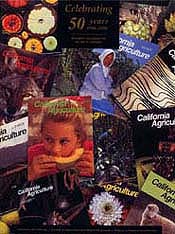


University of California
California Agriculture
|
|||
|
|||

Celebrating 50 Years: 1946-1996
Cover:
A sampling of California Agriculture covers. Photo by Suzanne Paisley.
November-December 1996
Volume 50, Number 6 News and opinionGeneral Information |
|||
|
University of California, 1301 S. 46th St., Bldg. 478 Richmond, CA
|